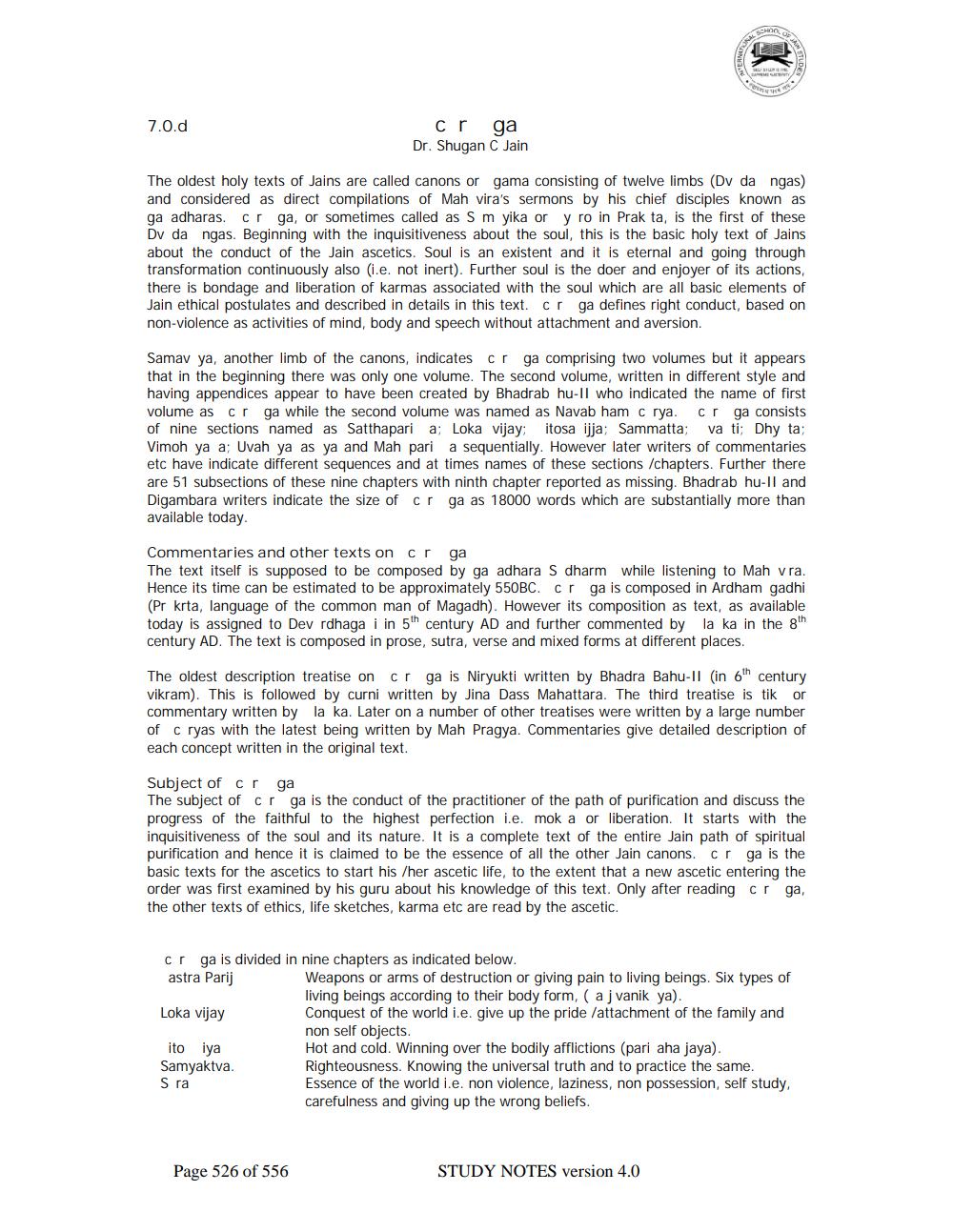________________
7.0.d
cr ga Dr. Shugan C Jain
The oldest holy texts of Jains are called canons or gama consisting of twelve limbs (Dv da ngas) and considered as direct compilations of Mah vira's sermons by his chief disciples known as ga adharas. cr ga, or sometimes called as S m yika or y ro in Prak ta, is the first of these Dv da ngas. Beginning with the inquisitiveness about the soul, this is the basic holy text of Jains about the conduct of the Jain ascetics. Soul is an existent and it is eternal and going through transformation continuously also (i.e. not inert). Further soul is the doer and enjoyer of its actions, there is bondage and liberation of karmas associated with the soul which are all basic elements of Jain ethical postulates and described in details in this text. cr ga defines right conduct, based on non-violence as activities of mind, body and speech without attachment and aversion.
Samav ya, another limb of the canons, indicates cr ga comprising two volumes but it appears that in the beginning there was only one volume. The second volume, written in different style and having appendices appear to have been created by Bhadrab hu-II who indicated the name of first volume as cr ga while the second volume was named as Navab ham c rya. cr ga consists of nine sections named as Satthapari a; Loka vijay; itosa ijja; Sammatta; va ti; Dhy ta; Vimoh ya a; Uvah ya as ya and Mah pari a sequentially. However later writers of commentaries etc have indicate different sequences and at times names of these sections /chapters. Further there are 51 subsections of these nine chapters with ninth chapter reported as missing. Bhadrab hu-Il and Digambara writers indicate the size of cr ga as 18000 words which are substantially more than available today.
Commentaries and other texts on cr ga
The text itself is supposed to be composed by ga adhara S dharm while listening to Mah vra. Hence its time can be estimated to be approximately 550BC. cr ga is composed in Ardham gadhi (Pr krta, language of the common man of Magadh). However its composition as text, as available today is assigned to Dev rdhaga i in 5th century AD and further commented by la ka in the 8th century AD. The text is composed in prose, sutra, verse and mixed forms at different places.
The oldest description treatise on cr ga is Niryukti written by Bhadra Bahu-II (in 6th century vikram). This is followed by curni written by Jina Dass Mahattara. The third treatise is tik or commentary written by la ka. Later on a number of other treatises were written by a large number of c ryas with the latest being written by Mah Pragya. Commentaries give detailed description of each concept written in the original text.
Subject of cr ga
The subject of cr ga is the conduct of the practitioner of the path of purification and discuss the progress of the faithful to the highest perfection i.e. mok a or liberation. It starts with the inquisitiveness of the soul and its nature. It is a complete text of the entire Jain path of spiritual purification and hence it is claimed to be the essence of all the other Jain canons. cr ga is the basic texts for the ascetics to start his /her ascetic life, to the extent that a new ascetic entering the order was first examined by his guru about his knowledge of this text. Only after reading cr ga, the other texts of ethics, life sketches, karma etc are read by the ascetic.
cr ga is divided in nine chapters as indicated below.
astra Parij
Loka vijay
ito iya Samyaktva. S ra
Page 526 of 556
Weapons or arms of destruction or giving pain to living beings. Six types of living beings according to their body form, (a j vanik ya).
Conquest of the world i.e. give up the pride /attachment of the family and non self objects.
Hot and cold. Winning over the bodily afflictions (pari aha jaya). Righteousness. Knowing the universal truth and to practice the same. Essence of the world i.e. non violence, laziness, non possession, self study, carefulness and giving up the wrong beliefs.
STUDY NOTES version 4.0




